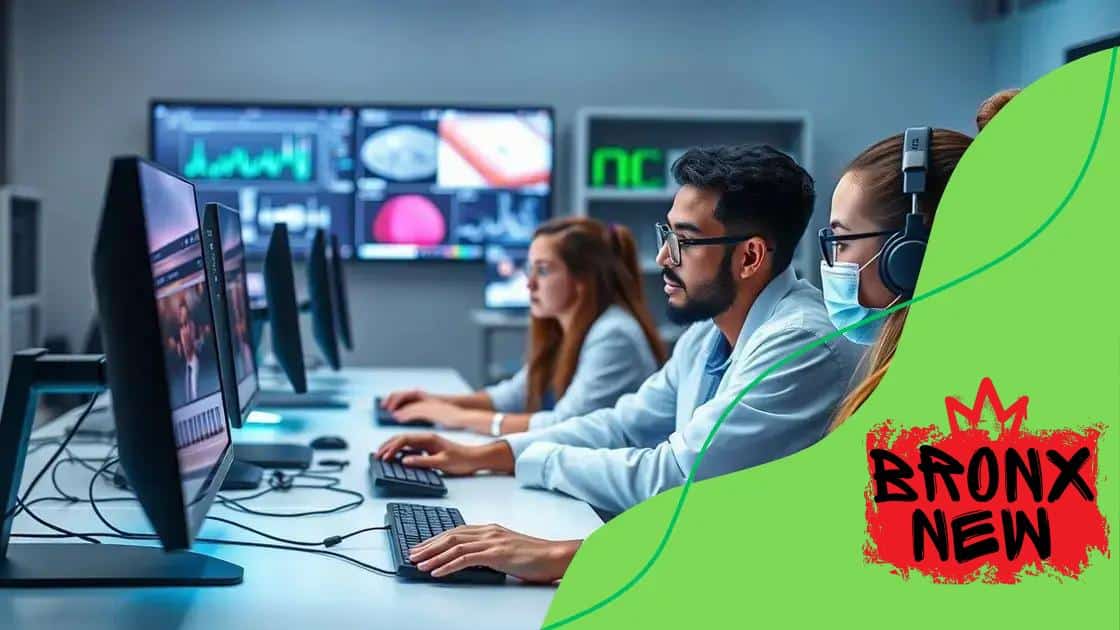Virtual labs for STEM education: engage students today

Virtual labs for STEM education provide interactive environments that enhance student engagement, promote personalized learning, and prepare students with essential skills through innovative technologies like AR and VR.
Virtual labs for STEM education are transforming the way students learn by providing engaging, hands-on experiences remotely. Have you ever wondered how these labs can bridge the gap between theory and practice? Let’s dive into this innovative approach together.
Understanding virtual labs: what they are
Virtual labs are innovative learning environments that allow students to conduct experiments and explore scientific concepts online. Instead of being limited to traditional labs, students can access a variety of simulated experiments that mimic real-world scenarios.
These labs often use interactive software that lets students manipulate variables and observe outcomes in a controlled setting. This experience not only enhances understanding but also increases engagement in STEM subjects.
What are virtual labs?
Essentially, virtual labs provide a safe and efficient way for students to learn through experimentation. They can experiment with complex scientific principles in ways that physical labs might not allow.
Key features of virtual labs
- Accessibility: Students can access labs anytime, anywhere, using computers or tablets.
- Interactive Elements: Labs often include simulations that respond to student inputs, enriching the learning experience.
- Safe Environment: Students can explore without the risk of accidents or equipment damage.
In addition to these features, virtual labs often provide instant feedback. This allows students to learn from mistakes quickly and adjust their approaches based on the outcomes they observe.
Moreover, these labs can accommodate different learning styles. Visual learners benefit from seeing simulations, while kinesthetic learners can engage with interactive features. With the use of virtual labs, students are likely to retain information better due to the hands-on approach.
Finally, as technology continues to advance, the capabilities of virtual labs will expand even further, offering new ways for students to engage with STEM subjects that keep pace with modern scientific developments.
Benefits of virtual labs for STEM education
Virtual labs offer numerous benefits for students engaging in STEM education. By providing an interactive and immersive experience, they change how learners interact with scientific concepts. This hands-on approach fuels curiosity and encourages exploration beyond traditional methods.
Students gain invaluable experience without the limitations of a physical lab. They can perform experiments, manipulate variables, and see results instantaneously. This ability to practice in a digital environment enhances their problem-solving skills.
Key advantages of virtual labs
Several specific advantages make virtual labs an effective tool in STEM education.
- Cost-Effectiveness: Schools can save on materials and equipment needed for physical labs.
- Flexibility: Students can engage with content at their own pace and revisit experiments as needed.
- Diverse Scenarios: Access to experiments that may be too dangerous or impractical in real life.
Furthermore, virtual labs adapt to different learning styles. Visual learners benefit from dynamic simulations, while kinesthetic learners engage through hands-on interactions. This adaptability helps create a tailored learning experience that suits various student needs.
With the rise of technology, virtual labs also provide insights into real-world applications. Students can relate what they learn to actual scientific practices, preparing them for future academic or career paths in STEM fields.
In every aspect, the integration of virtual labs represents a shift in STEM education, fostering a more engaging, accessible, and interactive approach to learning. This change is not just about technology; it’s about enhancing education for the future.
How virtual labs enhance student engagement

Virtual labs play a crucial role in engaging students and making learning enjoyable. By combining interactive elements with real-world scenarios, these labs capture the attention of students more effectively than traditional classroom settings.
One major way that virtual labs enhance engagement is through their immersive experiences. Students can explore scientific concepts by simulating experiments right from their computers. This freedom to explore leads to a deeper understanding of STEM subjects.
Interactive Learning
The interactivity of virtual labs keeps students actively participating in their learning. Unlike passive reading or lecture-based formats, students manipulate variables and analyze results in real-time. This leads to higher retention of information.
Encouraging Curiosity
Curiosity is essential for learning, and virtual labs spark this curiosity. When students can ask questions and experiment freely, they become more invested in their education. This natural inquisitiveness enhances their motivation and helps them connect classroom learning with real-life applications.
- Access to a diverse range of experiments.
- Immediate feedback on their actions.
- The ability to repeat experiments without extra costs.
Moreover, virtual labs cater to various learning styles. Visual learners benefit from interactive simulations, while kinesthetic learners thrive when engaging with hands-on digital tools. By accommodating these different needs, virtual labs ensure that all students feel included and motivated to participate.
As technology continues to evolve, the capabilities of virtual labs will also expand. This evolution means that student engagement will only improve, leading to more successful learning outcomes in STEM fields.
Implementing virtual labs in the classroom
Implementing virtual labs in the classroom can transform the learning experience for students. These labs provide hands-on practice that traditional methods often lack. When teachers integrate virtual labs into their lessons, they create exciting learning opportunities.
The first step in implementing virtual labs is selecting the right platform. There are many options available that cater to different subjects and age groups. It’s crucial to choose a lab that aligns with your curriculum and teaching goals.
Steps to implement virtual labs
Here are some key steps to effectively incorporate virtual labs into classroom instruction:
- Assess student needs and learning objectives.
- Choose an accessible and user-friendly platform.
- Plan lessons that incorporate virtual lab activities.
- Provide training and support for both teachers and students.
Once the right platform is chosen, teachers should prepare students for the new learning experience. This preparation includes explaining the benefits of virtual labs and how they will enhance their understanding of the subject matter.
In addition, virtual labs promote collaboration among students. They can work together on experiments, ask questions, and discuss their findings in real-time. This collaborative aspect leads to deeper learning as students engage with one another.
Moreover, teachers can track student progress through virtual labs. Many platforms offer analytics that shows how students are performing, enabling educators to adapt instruction as needed. This data-driven approach helps enhance overall learning outcomes.
By implementing virtual labs into the classroom, educators empower students to take charge of their learning experiences. They foster an environment where students can explore, experiment, and engage with STEM subjects in innovative ways.
Future of STEM education with virtual labs
The future of STEM education is vibrant and dynamic, largely due to the rise of virtual labs. These digital environments offer students exciting new ways to learn and interact with scientific concepts. As technology continues to evolve, the impact of virtual labs will transform traditional education.
One major aspect of the future of STEM education is personalization. Virtual labs allow students to learn at their own pace. They can revisit complex concepts until they feel confident. This tailored learning experience helps students grasp material thoroughly and effectively.
Advancements in technology
Emerging technologies, such as augmented reality (AR) and virtual reality (VR), are set to enhance the virtual lab experience even further. With these technologies, students will find themselves fully immersed in the learning process. Imagine conducting a chemistry experiment in a lifelike simulation that replicates a real lab environment.
- Interactive 3D models allowing for in-depth exploration.
- Enhanced collaboration tools enabling group experiments online.
- Data analysis tools that improve understanding of results.
Moreover, virtual labs encourage global collaboration. Students from different parts of the world can work together on projects, share their findings, and learn from diverse perspectives. This global community prepares them for future careers in a connected world.
As educators embrace technology, STEM education will increasingly integrate virtual labs into their curriculum. This integration will create a knowledge-rich environment where students are excited to learn and explore. By cultivating a love for learning through virtual labs, we prepare young minds for the challenges of tomorrow.
virtual labs are revolutionizing STEM education by making learning interactive and engaging. They offer a safe environment for students to explore and experiment, promoting curiosity and critical thinking. With future advancements in technology, the potential for virtual labs is limitless, paving the way for a new generation of learners. Incorporating these tools into the classroom equips students with skills that will be essential in their future careers. Together, we can embrace this innovative approach to education and inspire students to reach their full potential.
FAQ – Frequently Asked Questions about Virtual Labs in STEM Education
What are virtual labs?
Virtual labs are digital environments that allow students to conduct experiments and learn scientific concepts online, providing an interactive and engaging learning experience.
How do virtual labs enhance student engagement?
Virtual labs promote active participation, curiosity, and collaboration among students, making learning more enjoyable and effective compared to traditional methods.
Are virtual labs suitable for all learning styles?
Yes, virtual labs cater to various learning styles by offering interactive simulations for visual learners and hands-on activities for kinesthetic learners.
What technology is used in virtual labs?
Virtual labs often incorporate advanced technologies like augmented reality (AR) and virtual reality (VR) to create immersive learning environments.





